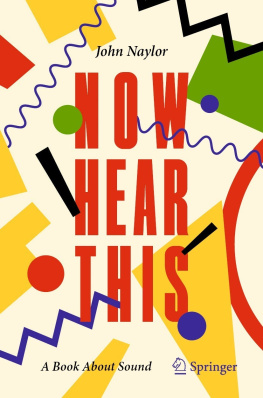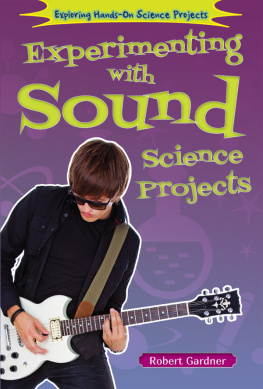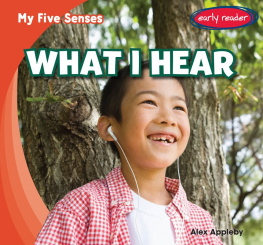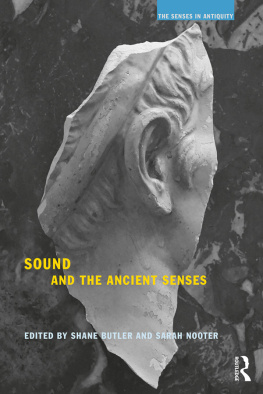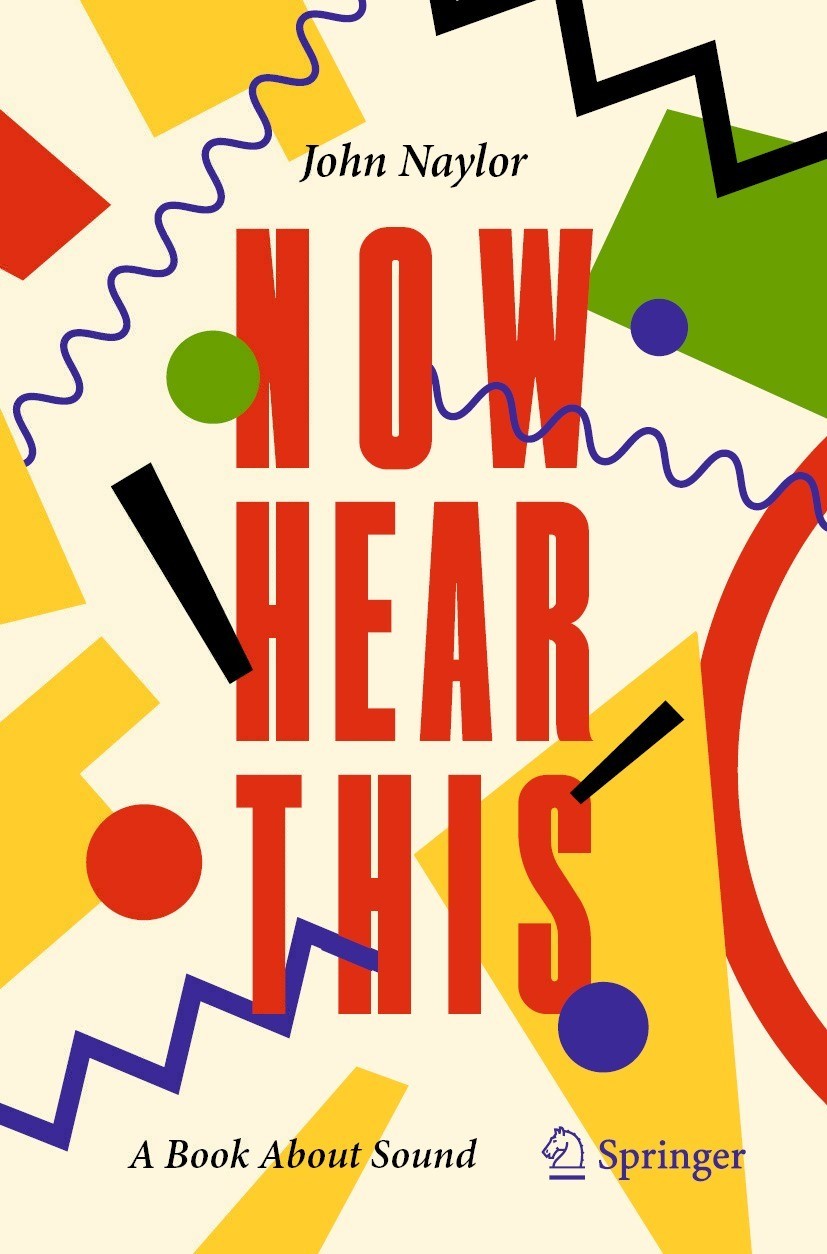John Naylor
Now Hear This
A Book About Sound
1st ed. 2021

Logo of the publisher
ISBN 978-3-030-89876-2 e-ISBN 978-3-030-89877-9
https://doi.org/10.1007/978-3-030-89877-9
The Editor(s) (if applicable) and The Author(s), under exclusive license to Springer Nature Switzerland AG 2021
This work is subject to copyright. All rights are solely and exclusively licensed by the Publisher, whether the whole or part of the material is concerned, specifically the rights of translation, reprinting, reuse of illustrations, recitation, broadcasting, reproduction on microfilms or in any other physical way, and transmission or information storage and retrieval, electronic adaptation, computer software, or by similar or dissimilar methodology now known or hereafter developed.
The use of general descriptive names, registered names, trademarks, service marks, etc. in this publication does not imply, even in the absence of a specific statement, that such names are exempt from the relevant protective laws and regulations and therefore free for general use.
The publisher, the authors and the editors are safe to assume that the advice and information in this book are believed to be true and accurate at the date of publication. Neither the publisher nor the authors or the editors give a warranty, expressed or implied, with respect to the material contained herein or for any errors or omissions that may have been made. The publisher remains neutral with regard to jurisdictional claims in published maps and institutional affiliations.
This Springer imprint is published by the registered company Springer Nature Switzerland AG
The registered company address is: Gewerbestrasse 11, 6330 Cham, Switzerland
Sue and her keen ears
Acknowledgements
Like any book that deals with facts and theories that are not the authors own, this one required the help and advice of a large number of people. A fair number of those are the authors of the books and papers I have consulted, and whose names are to be found in the bibliography. Online videos enabled me to pay virtual visits to far away places and listen to the sounds associated with them. I also owe a debt to the those who asked me questions while writing the book, especially the questions that tested my understanding, giving me an opportunity to get things straight.
Particular thanks are owed to Prof. Geoffrey Manley, Steve Tunnicliffe, Antony de Peyer and Joe Naylor who read some of the chapters and offered useful and constructive advice, correcting errors and helping me to express myself more clearly and succinctly. Thanks also to Dr. Gianluca Memoli for organising a visit to the anechoic chamber at the National Physical Laboratory in Teddington. Among those who answered queries or asked searching questions are Dr. Javier Amezcua, Dr. Bruno Fazenda and Les Cowley.
Others who have contributed include Jos Widdershoven (walks and translations), Bob Bery (whispering galleries), Ben Cuddon (whistling jugs), Julian Mumby (Woodstock echo), Mike Benson (lessons in clapping), Francesca Phillips (whistled language of La Gomera), and all the people who have accompanied me on sounds walks in and around London.
Most importantly, I thank Sue, my dear wife, for her company, love, patience and encouragement, who never doubted that this project would see the light of day and whose acute hearing came in useful on many occasions.
Introduction
I have to begin with a confession: I am not by nature a listener. I seldom pay heed to sounds with the same degree of interest and attention as I do to sights. I like to stand and stare, but all too often I fail to linger and listen. At least, such was the situation before I set about writing this book. I now realise that for most of my life I have invariably ignored the vast majority of sounds I have heard in the mistaken belief that they are inconsequential, uninteresting or irritating.
Now, well past middle age, and almost certainly soon in need of hearing aids I am increasingly aware that I no longer hear high frequencies, the very frequencies that give sounds the clarity and bite which are essential to comprehending clearly what is being said to me. So having belatedly resolved to make up for lost time and listen to the world as attentively as I look at it, I now find myself in a race to make the most of what remains of the hearing I took for granted in my youth before my acoustic compass is reduced to murmurs and mumbles.
This book is the product of that decision. It is aimed squarely at anyone with an interest in science and the natural world but who is as unaware of their soundscape as I once was. There are six chapters dealing with the subjective aspects of hearing and listening; the history of some of the key events and discoveries that have led to our present knowledge about the nature of sound; the nature of sound considered both as a physical phenomenon and as a sensation; the workings of the hearing system and how it has evolved in vertebrates; the passage of sound in air and in water; the many ways sounds interact with the environment and the effects of those interactions on what we hear; explanations of a host of sounds and acoustic effects, ranging from the commonplace to the unusual. The footnotes that pepper the text supply annotations to the core textfor no book is entire of itself. My research has been based on primary sources, expert advice and, wherever possible, first hand personal experience of the sounds I write about.
Compared to sight hearing is a hugely underrated sense, not least because we unconsciously assume that the world discloses itself to us most fully by means of light. We seldom pay heed to sounds with the same degree of interest and attention as we do to sights. In almost every situation we are usually far more aware of what we see than what we hear. By habitually ignoring or paying scant attention to sounds we pass up the opportunity to engage more closely with our soundscape, something that will increase our knowledge and awareness of the world at large, not to mention missing out on the unexpected sensuous and intellectual delights that are the true reward of active listening.
A book about sound must also be book about listening. It is only as one learns what to listen for that one begins to engage more fully with ones soundscape because hearing goes well beyond mere sensation. It is a creative act that melds raw auditory sensations with expectation, motive, memory and knowledge to forge a rounded experience of ones sonic environment. Descriptions and explanations of how particular sounds are produced, propagated and altered in a given situation greatly helps here, but is never the whole story, for sounds have psychological and physiological aspects that physical science does not address. The sensations that characterise sound, such as loudness and pitch, are not replicas of the physical vibrations that stimulate them, though that is something very few of us are aware of.
In thrall to the stark and reassuring certainties of physics, during my thirty years of teaching the subject I blithely assumed that there is little more to any sound than complex vibrations within a medium and their interactions with the objects they encounter. I considered that hearing was merely a useful though minor adjunct to those facts. What need for ears when there are mathematical formulas and scientific instruments with which to analyse and make sense of the vibrations we experience as sound? I took it for granted that physics could, and did, tell me everything worth knowing about sound and hearing. How wrong I was. I now realise that although there can be no sound without vibrations to stimulate the hearing system, sounds and the vibrations that give rise to them are worlds apart. One is a visceral, flesh and blood sensation, the other a noiseless physical event.

